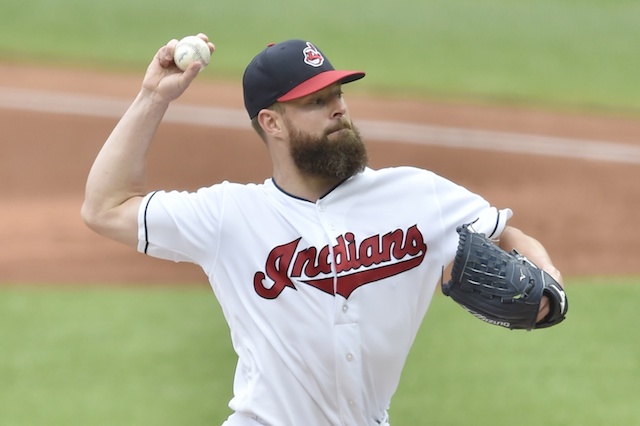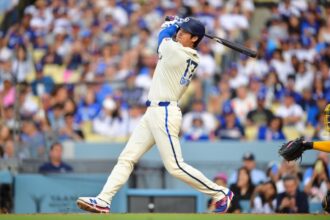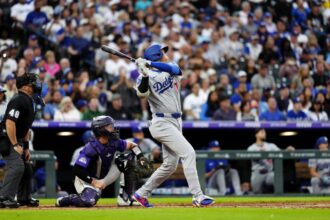In effort to get a better idea of how the Los Angeles Dodgers match up with the Washington Nationals, let’s take a look at the starting rotations and bullpens. The Dodgers and Nationals had two of the best staffs in the Majors this season.
Washington was second overall with a 3.52 ERA, while the Dodgers placed fifth with a 3.70 ERA. The Nationals were also second in FIP at 3.58, while the Dodgers were third at 3.61. Washington’s starters produced a 3.60 ERA, second-best in baseball, while the Dodgers’ rotation sported a 3.95 mark, ranking sixth.
The bullpens were the best in the league, with the Dodgers holding an MLB-best 3.35 ERA, and the Nationals just behind them with a 3.37 ERA. But that’s enough about the numbers. Let’s take a look at the players.
Los Angeles has the best 1-2 punch in the league. Since the beginning of last season, no two starters have lower ERAs than Clayton Kershaw and Rich Hill (minimum 100 innings pitched). While Kershaw missed more than two months, he’s allowed just six runs in five starts since returning.
Hill has had his share of injury issues as well, missing more than one start due to blisters, but has been dominant when healthy to the tune of a 2.00 ERA since 2015. Of course, there is the narrative that Kershaw doesn’t pitch well in the postseason.
The faults in that line of thinking are clear when taking into account the small sample size and bad luck Kershaw has encountered. Meanwhile, Hill has pitched in just one postseason game during his career.
In a 2007 start for the Chicago Cubs, he allowed three runs in as many innings. However, Hill is not the same pitcher he was nearly a decade ago.
For the Nationals, they have one of the best pitchers in the game going for them in the opener: Max Scherzer. Scherzer won the AL Cy Young award in 2013 with the Detroit Tigers, he’s finished in the top five in voting the past two seasons, and he could win the award again this year.
Scherzer has pitched well in the division series during his career, with a 2.79 ERA in six games (four starts). Washington’s other ace, Stephen Strasburg, was shut down after a Sept. 7 start with a flexor mass strain, and was officially ruled out for the NLDS.
That leaves the Nationals to choose between lefty Gio Gonzalez and righty Tanner Roark for Games 2 and 3. Manager Dusty Baker could play the odds and start Gonzalez in Game 2 against a team that’s had difficulties hitting southpaws on the road.
Baker could also go with Roark, whose 2.83 ERA ranked sixth in the Majors this season. Joe Ross, a 23-year-old righty, would figure to be the No. 4 starter if Washington need one during the series.
Behind Kershaw and Hill, the Dodgers will toss Kenta Maeda out for Game 3. Maeda did very well in his MLB-debut season, posting a 3.48 ERA while leading the team with 32 starts. He matches up pretty well with Roark and Gonzalez.
The fourth starter is the biggest question mark. If the Dodgers are down in the series, you can bet Kershaw will demand the ball for Game 4. If they’re up 2-1, the club has some options for that final rotation spot.
It seems almost impossible to say, but their best bet would be Julio Urias. The 20-year-old was fourth on the team in terms of Fangraphs WAR this season. Even if it’s an abbreviated outing (three-four innings), Urias probably gives the Dodgers the best chance to win.
So, as far as the rotation goes, the Nationals missing Strasburg means the Dodgers get the nod in that department. Now, let’s take a look at the bullpens.
Washington did a great job of adding Mark Melancon to their relief corps once Jon Papelbon’s season went belly-up. Shawn Kelley, who signed a three-year contract last winter, has been an excellent setup man.
Sammy Solis, a hard-throwing southpaw, has dominated lefties and more than held his own versus righties. Likewise, the Dodgers have a reliable trio at the back of their bullpen.
Kenley Jansen has been one of the best closers in baseball over the past seven years, ranking third over that span in fWAR behind only Craig Kimbrel and Aroldis Chapman. Joe Blanton, who didn’t even pitch in the Majors two years ago, has been one of the biggest surprises in baseball over the past two seasons, recreating himself as an outstanding setup man.
Grant Dayton, picked up in a Minor League trade that sent 2011 first-rounder Chris Reed to Miami, has flourished as a late-inning reliever. Other components in each bullpen match up well, too.
For the Nationals, journeyman Matt Belisle got better as the season wore on and ended the season with a 1.76 ERA. Hard-throwing Blake Treinen posted an ERA of 2.28. And Mark “The Eyechart” Rzepczynski was acquired a week before the playoff eligibility deadline to give the club a solid LOOGY.
The Dodgers have lost some reliable relief arms to injury this season. Adam Liberatore, the club’s premier lefty out of the pen a year ago, underwent elbow surgery. Yimi Garcia, the team’s third-best reliever in fWAR from 2015, was lost in April and required knee surgery.
But the Dodgers’ depth has compensated for their losses. Luis Avilan and Pedro Baez returned from Minor League assignments with renewed productivity. Alex Wood, who started this year before undergoing elbow surgery, has been solid in a handful of relief outings.
Though barring a surprise, Wood will not be on the NLDS roster. Even trade-deadline pickups Josh Fields and Jesse Chavez have been solid.
It seems that the bullpens are very evenly matched. The rotations would be equal were Strasburg able to contribute. But given the fact that Kershaw and Hill are healthy, coupled with how closely the bullpens mirror each other, the Dodgers have the advantage on the mound going into the series.
You can listen to Jared on the weekly Dugout Blues Podcast








